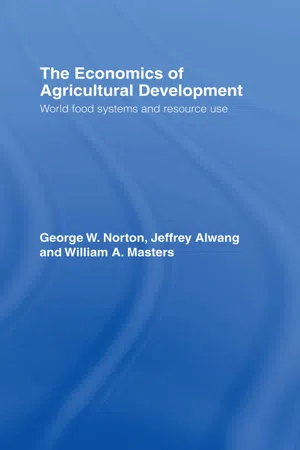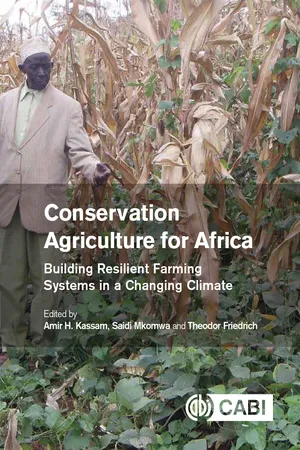Geography
Mechanized Farming
Mechanized farming refers to the use of agricultural machinery and equipment to perform farming tasks. This includes tractors, harvesters, and irrigation systems, which increase efficiency and productivity in agriculture. Mechanized farming has revolutionized the industry by reducing the need for manual labor and enabling larger-scale production.
Written by Perlego with AI-assistance
Related key terms
2 Key excerpts on "Mechanized Farming"
- eBook - ePub
The Economics of Agricultural Development
World Food Systems and Resource Use
- George W. Norton, Jeffrey Alwang, William A. Masters(Authors)
- 2014(Publication Date)
- Routledge(Publisher)
2 The controversy arises because machinery usually substitutes for labor or animals. In many developing countries, labor is abundant and its cost is low. Alternative employment opportunities outside agriculture are limited, so that labor displacement is undesirable. Therefore, mechanization is most profitable in countries where land is abundant, labor is scarce, and capital is cheap; this situation would seem to exist in relatively few countries,Does this mean that there is little role for agricultural mechanization? Not necessarily, but the types of mechanization should be different from what is observed in most Western developed countries. Highly productive cropping systems, whether on small or large farms, can often benefit from more precise planting depths and fertilizer placement, mechanically pumped irrigation water, mechanical threshing (but usually not harvesting unless labor is scarce), transport, power spraying of pesticides, and tilling when timing is critical for multiple cropping. Many of these mechanical devices, however, may be handheld (e.g., sprayers) or stationary (e.g., pumps and threshers). Even in areas where labor is usually abundant, shortages can occur in certain seasons, which, if relieved through mechanization, could increase the overall demand for labor.Individual farmers will consider the private profitability when deciding whether to invest in a machine. If very large farms exist in countries with surplus labor in agriculture, operators of these farms may prefer labor-saving machinery because it allows them to deal with fewer employees, and, given the transactions costs and capital subsidies that may exist, it may be more privately profitable to follow large-scale mechanization even if society as a whole would be better off without it. Such behavior is one of the reasons why land reform is so important to many developing countries (see Chapter 13 ).Treating cattle for parasites in EthiopiaGovernments and foreign assistance agencies must be careful not to encourage non-optimal mechanization (from society’s viewpoint) through ill-advised subsidies or other means. Mechanization is inevitable over time, but the type of mechanization should be appropriate given the relative endowments of land, labor, and capital. Certain government policies, such as those influencing exchange rates, indirectly affect the prices of capital-intensive inputs such as machinery. Impacts on relative prices of inputs should be considered during policy formulation. - eBook - ePub
Conservation Agriculture for Africa
Building Resilient Farming Systems in a Changing Climate
- Amir Kassam, Saidi Mkomwa, Theodor Friedrich(Authors)
- 0(Publication Date)
- CABI(Publisher)
In many regions there is a growing labour shortage for production in commercial farming. This is also increasingly true in smallholder family farms where alternative opportunities are sought in the urban sector (leading to increasing rural–urban migration). Where family labour is the main source of farm power, there is a limit to the area of land that can be managed and how much production can be handled. Where production intensification is involved, mechanization is seen to be an important input as it improves the timeliness of operations for crop establishment and for weed control, offers opportunity for area expansion where extra land is available and also increases labour productivity. Of course, mechanization generally means greater financial investment and this can be a constraint unless service providers can offer affordable services or where there is government support to purchase equipment and machinery for sharing. In the case of smallholders in Africa, there is an increasing demand and opportunity for appropriate and affordable mechanization options.Improved timeliness of farm operations such as early or timely direct no-till sowing leads to mobilizing greater land and crop potentials. Often two to three weeks can be lost in the case of tillage agriculture in preparing the land for crop establishment by ploughing and harrowing, which leads to loss of soil moisture and delayed sowing. Similarly, there is improvement in yield and a reduction in labour requirement that can lead to greater labour productivity.11.3.5 Improved cropping in marginal environments and increasing cropping ratios
In semi-arid areas of Africa where the rainfed growing period is short (90–150 days with 400–800 mm rainfall) and where rainfall variability is high, mechanized CA can improve the quality and length of the growing period. This improvement is possible because the loss of soil moisture before sowing is reduced to a minimum, early sowing can be achieved with mechanized CA and maximum rainfall water can be captured and retained in the soil. Also, with an improved length of growing period and moisture condition, cover crops can be undersown a few weeks before the main crop is harvested. This leads to production of extra biomass, adding additional carbon and biologically fixed nitrogen to the soil (if legumes are used) and improving soil cover for longer. All this imparts greater resilience to production systems, significantly reduces the chances of crop failure and minimizes yield reductions during difficult years.
Learn about this page
Index pages curate the most relevant extracts from our library of academic textbooks. They’ve been created using an in-house natural language model (NLM), each adding context and meaning to key research topics.

